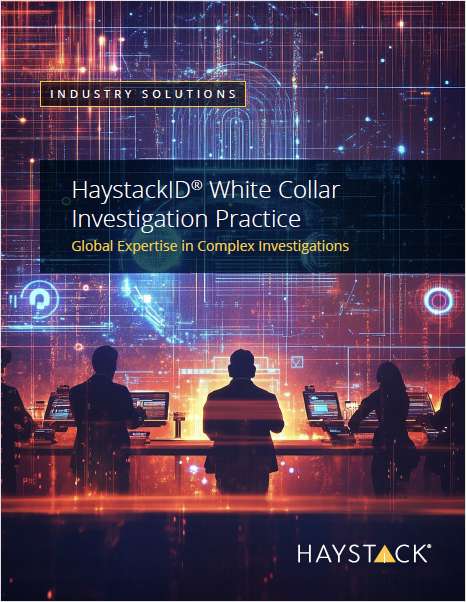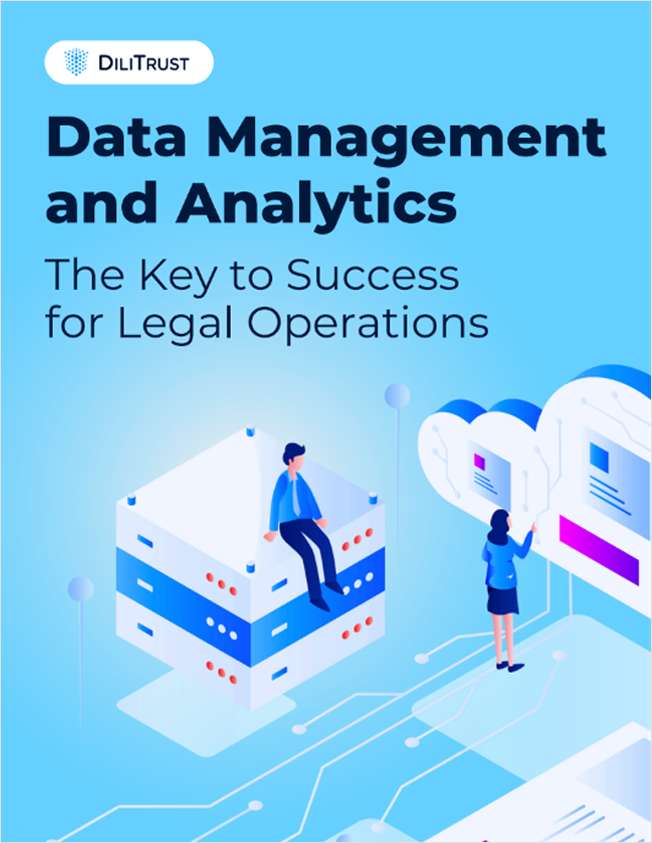How Cultivating Existing Client Relationships Can Boost Business Development
Advances in CRM software can help connect lawyers across the firm, allowing them to compete as one firm and build on the successful results they have already delivered for clients.
June 30, 2020 at 10:44 PM
9 minute read
This article appeared in Cybersecurity Law & Strategy, an ALM publication for privacy and security professionals, Chief Information Security Officers, Chief Information Officers, Chief Technology Officers, Corporate Counsel, Internet and Tech Practitioners, In-House Counsel. Visit the website to learn more.
There is nothing worse than meeting with your client and discovering to your surprise they are having discussions, good or bad, with other members of your firm. Such dissonance within the firm can undermine the trust of your clients and compromise your business development and client retention efforts. From a client perspective, these missteps tarnish their experience with your firm. From the firm perspective, instead of working to expand business with these clients, you must now fight to repair the relationship. In today's time-constrained law firm, however, it is often difficult to track such client engagements, let alone manage or understand them. Fortunately, advances in client relationship management (CRM) software can help connect lawyers across the firm, allowing them to compete as one firm and build on the successful results they have already delivered for clients.
Strategic business development is critical to support firm growth, and CRM software is the backbone of a data-driven approach. It not only helps your firm prospect for future clients, but also helps you strengthen and expand existing client relationships. If you are going to manage your relationship with a client in a truly holistic way that builds trust and confidence, you need to know who from within your firm has relationships with the client at every level of the organization. You also need to understand the nature of those relationships, the different means of communication (e.g., meetings, emails, calls) and the frequency of engagement. Finally, once you have this unified view, you need to make it readily available and easily accessible to everyone who needs it within your organization. All of this relationship data already exists – you merely need the right technologies to unlock its power and potential.
Below are a few ways to leverage data and software to improve your client experience and create future opportunities.
|Create a Data-Driven Strategy to Build Future Business
One of the inherent problems law firms have with using data to develop more business is the fact that they are big and complex — and so are their clients. In many cases, more than one practice group or industry group within the same firm is working with the same client. How do they know they are working with the same client and, if so, how can the firm coordinate efforts to improve that client's experience?
Advanced CRM systems allow firms to benefit from both broad and granular insight into all touchpoints with a client. Before meeting with a client, review the data available to understand how the client has been engaging with your firm as a whole — meetings with other practice areas, attending firm events, engaging with marketing communications, etc. Then, after each meeting, make sure to add any information discovered to keep the records current and accurate. With the information constantly being accessed, reviewed and updated, a CRM becomes a critical tool that can help identify and uncover new opportunities.
For example, if a law firm has a large corporation such as Walmart as a client, and Walmart uses that firm for corporate litigation, contracts management and the occasional M&A or securities-related transaction, the firm would routinely capture information on each matter in its CRM solution. The firm could look back into the historic data about its interactions with Walmart to view patterns in the data and analyze the company's purchasing behavior. These patterns would allow the firm to predict future buying behaviors and cater to them accordingly.
In another scenario, let's say a particular client uses a law firm at a specific time of year for seasonal work. The firm can configure its CRM to issue an internal alert in anticipation of the client's needs prior to the seasonal call, thus enabling a highly responsive level of customer service. Proactive steps like this can earn client loyalty and may make a big difference when the client is looking for additional legal services.
|Capture Client Interactions to Empower Decision-Making
Bringing together client information to provide a firm-wide view of what is taking place is essential to find the insights to drive strategic action. In order to properly generate and execute a solid plan for a strategic client, firms need to take a holistic view:
- Where do we have relationships?
- Where do we need relationships?
- What are the client's goals we can help with?
- Where is there "white space" (g., industry, practice area, location, revenue, size) in the relationship, and how do we plan to expand into those areas?
By capturing client interactions, CRM software can help complete a holistic picture of a client's needs and understand how well the firm is delivering on those needs. Advanced CRM systems even automate many of these processes, like logging calls and emails, or capturing new contacts from email signature files, so practitioners don't need to disrupt their workflow for what is perceived to be non-core, non-billable activity.
The CRM tracks what has been discussed with the client, what action both that client and the firm have taken, and what progress has been made. In a business development scenario, leveraging CRM data can help members of your firm quickly and easily find out who has the strongest relationships with existing clients or prospective clients the firm seeks to work with. Instead of sending out annoying, firm-wide emails asking, "Who knows Ms. X at Client Y?" a quick search of the CRM data can point users directly to the people who can deliver the insights or expertise they need to achieve the firm's growth objectives. Some CRM software captures client engagement scores, a numerical value based on the breadth and depth of activity and communication in the relationship. Monitoring engagement scores can help firms better understand where they have strong relationships, where you need to build new relationships, and how to revitalize the relationship if the engagement score starts to decrease.
|Create a Data-Driven Culture That Places Client Intelligence At the Heart of Every Engagement
As corporations continue to consolidate their legal spend with a smaller number of firms, their expectations for the experience with each firm are greater. Firms that truly become data-centric, implementing tools and processes that enable client information to be at the heart of every interaction, are the most likely to succeed. When data informs every action, client service improves and new business opportunities can be uncovered.
Building a data-driven culture starts with building trust. Employees must be confident the client data and information they are relying on is accurate. First, firms need to operationalize data management by implementing processes like regular monitoring of data quality through data health dashboards and a set of governance rules around duplicate management, data change management and more. Next, firms should look for solutions that help automate and support the processes they have put in place. For example, tools that passively capture data through email signatures can keep contact data up to date automatically updates.
Once trust is established, firms should work to build a cross-functional understanding of the client journey, experiences and preferences. One of the best way to accomplish this is to embed essential data into the day-to-day workflow of those interacting with clients on a regular basis. Surfacing this information where attorneys are already working — most likely Outlook or Word — means they do not have to go hunting for those insights and are more likely to use it to drive their actions.
Let's not forget the client benefits that emerge from this approach: Placing CRM data at the center of every relationship delivers more efficient knowledge-transfer, deeper insights and more effective collaboration, all of which lead to better client service and relationships. When firms are able to quickly capture essential data about clients and disseminate it firm-wide, the clients get the best possible experience and the firm earns the reputation of trusted adviser.
|Drive Firm Growth Through Strategic Planning
As data-driven practices permeate the organizational culture, firms will have a solid foundation on which to build longer-term business development strategies and deliver on firm objectives. They can look at data across the firm to better understand and manage their client development pipeline, and to develop and track targeted growth strategies like exploring new markets, targeting different industries or launching a new practice area.
CRM software is an effective growth management tool that helps firms identify areas of white space and develop a strategy for expanding into those areas. They can use it to mine and track client data, segment and profile clients, and then target communications accordingly. Once firms understand each client's unique goals and objectives, they can find the best introductions to generate new opportunities and then provide concise, consistent messaging across every customer experience to cement existing clients as ongoing sources of revenue.
Consider the earlier Walmart example. Without a CRM to allow attorneys to mine client information for useable insights, a firm will never be able to capitalize on the results being delivered for clients using the firm for disparate services. Using a CRM allows the firm to input all of its activities on behalf of Walmart and examine that information in a single view, so a lawyer anticipating a conversation with the client can easily to do all the necessary homework before s/he walks through the door. Bringing knowledge and understanding to the table instills confidence in the client and will make that client sticky for the long-term.
Using the above techniques, your firm can more effectively cultivate client relationships and develop data-based strategies for increasing growth and pursuing business development opportunities. When you put as much effort into understanding existing clients' objectives and goals as you do into acquiring new clients, you will discover opportunities arise. Get ahead of your competitors by nurturing existing clients and mining this resource that's already at your fingertips.
*****
Scott Wallingford is the Vice President and General Manager of LexisNexis Software Solutions business (@LexisNexisLegal). He brings over 20 years' experience in scaling nascent businesses and revitalizing mature ones. Scott's career includes senior leadership positions in software, telecommunications, and management consulting across the U.S., Europe and Asia. He holds a degree in electrical engineering from Northwestern University and an MBA in Finance from Duke University's Fuqua School of Business.
This content has been archived. It is available through our partners, LexisNexis® and Bloomberg Law.
To view this content, please continue to their sites.
Not a Lexis Subscriber?
Subscribe Now
Not a Bloomberg Law Subscriber?
Subscribe Now
NOT FOR REPRINT
© 2024 ALM Global, LLC, All Rights Reserved. Request academic re-use from www.copyright.com. All other uses, submit a request to [email protected]. For more information visit Asset & Logo Licensing.
You Might Like
View All
The Coming of Trump's Judicial Picks Spurs Liberals to Press for Biden's

Court Rules Mere Conduit Defense Not Suitable for a Motion to Dismiss
6 minute read

Big Law Expected To Follow Milbank's Lead With Associate Year-End Bonuses
Trending Stories
- 1Elon Musk Names Microsoft, Calif. AG to Amended OpenAI Suit
- 2Trump’s Plan to Purge Democracy
- 3Baltimore City Govt., After Winning Opioid Jury Trial, Preparing to Demand an Additional $11B for Abatement Costs
- 4X Joins Legal Attack on California's New Deepfakes Law
- 5Monsanto Wins Latest Philadelphia Roundup Trial
Who Got The Work
Michael G. Bongiorno, Andrew Scott Dulberg and Elizabeth E. Driscoll from Wilmer Cutler Pickering Hale and Dorr have stepped in to represent Symbotic Inc., an A.I.-enabled technology platform that focuses on increasing supply chain efficiency, and other defendants in a pending shareholder derivative lawsuit. The case, filed Oct. 2 in Massachusetts District Court by the Brown Law Firm on behalf of Stephen Austen, accuses certain officers and directors of misleading investors in regard to Symbotic's potential for margin growth by failing to disclose that the company was not equipped to timely deploy its systems or manage expenses through project delays. The case, assigned to U.S. District Judge Nathaniel M. Gorton, is 1:24-cv-12522, Austen v. Cohen et al.
Who Got The Work
Edmund Polubinski and Marie Killmond of Davis Polk & Wardwell have entered appearances for data platform software development company MongoDB and other defendants in a pending shareholder derivative lawsuit. The action, filed Oct. 7 in New York Southern District Court by the Brown Law Firm, accuses the company's directors and/or officers of falsely expressing confidence in the company’s restructuring of its sales incentive plan and downplaying the severity of decreases in its upfront commitments. The case is 1:24-cv-07594, Roy v. Ittycheria et al.
Who Got The Work
Amy O. Bruchs and Kurt F. Ellison of Michael Best & Friedrich have entered appearances for Epic Systems Corp. in a pending employment discrimination lawsuit. The suit was filed Sept. 7 in Wisconsin Western District Court by Levine Eisberner LLC and Siri & Glimstad on behalf of a project manager who claims that he was wrongfully terminated after applying for a religious exemption to the defendant's COVID-19 vaccine mandate. The case, assigned to U.S. Magistrate Judge Anita Marie Boor, is 3:24-cv-00630, Secker, Nathan v. Epic Systems Corporation.
Who Got The Work
David X. Sullivan, Thomas J. Finn and Gregory A. Hall from McCarter & English have entered appearances for Sunrun Installation Services in a pending civil rights lawsuit. The complaint was filed Sept. 4 in Connecticut District Court by attorney Robert M. Berke on behalf of former employee George Edward Steins, who was arrested and charged with employing an unregistered home improvement salesperson. The complaint alleges that had Sunrun informed the Connecticut Department of Consumer Protection that the plaintiff's employment had ended in 2017 and that he no longer held Sunrun's home improvement contractor license, he would not have been hit with charges, which were dismissed in May 2024. The case, assigned to U.S. District Judge Jeffrey A. Meyer, is 3:24-cv-01423, Steins v. Sunrun, Inc. et al.
Who Got The Work
Greenberg Traurig shareholder Joshua L. Raskin has entered an appearance for boohoo.com UK Ltd. in a pending patent infringement lawsuit. The suit, filed Sept. 3 in Texas Eastern District Court by Rozier Hardt McDonough on behalf of Alto Dynamics, asserts five patents related to an online shopping platform. The case, assigned to U.S. District Judge Rodney Gilstrap, is 2:24-cv-00719, Alto Dynamics, LLC v. boohoo.com UK Limited.
Featured Firms
Law Offices of Gary Martin Hays & Associates, P.C.
(470) 294-1674
Law Offices of Mark E. Salomone
(857) 444-6468
Smith & Hassler
(713) 739-1250








